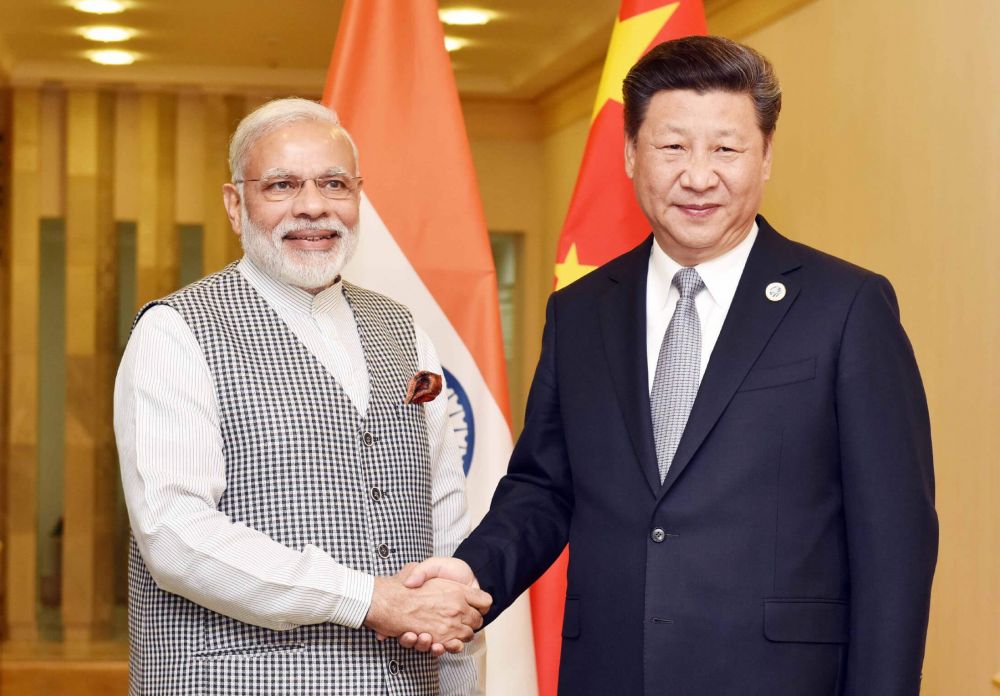India and China have had fraught relations for decades and crossed swords militarily as recently as 2017. Lately, notes 2019 AsiaGlobal Fellow Ananth Krishnan, New Delhi and Beijing have sought to pursue broader objectives and break out of the cycle of diplomatic ups and downs, with a view to bringing a greater degree of predictability and stability to the relationship at a time of increasing global flux. Yet several factors – from border disputes to trade imbalances to relationships with neighbors and allies – keep getting in the way.
Modi and Xi reset relations: India and China try to move beyond their long-running cycle of diplomatic ups and downs
Over two days of grand summitry in mid-October 2019 in the southern coastal town of Mamallapuram, near Chennai, Chinese leader Xi Jinping and Indian Prime Minister Narendra Modi had sought to send a strong message to the world that despite the many problems in the two neighbors' relationship, they were determined to work it out. Yet not even a month after Xi Jinping had left India, New Delhi announced its decision to withdraw from talks for the Regional Comprehensive Economic Partnership (RCEP), an ASEAN-led, China-favored trade grouping. (Participants include China, India, all 10 ASEAN member states, Australia, Japan, Korea and New Zealand.)
Even though it was widely known that India had been holding up conclusion of the long-running negotiations, the announcement still came as a surprise. The official word was that the door was still open for India's entry at a later date, as long as its concerns, particularly over market access in the services sector, would be addressed. No one was saying it publicly, but the real reason for Delhi’s departure was China.
As much as the optics of Xi’s autumn visit were remarkably positive — the sight of Modi and Xi holding each other’s arms aloft against the backdrop of a looming boulder was a powerful image — India’s quitting RCEP served a timely reminder of the challenges that lie ahead for the relationship. One of them is certainly trade, including concerns about what the regional deal would mean to a market already grappling with a ballooning trade deficit with the world’s second-largest economy.
Informal formalities
The nature of the “informal” summit, which was the second such meeting between India and China — with no negotiated joint statement or list of agreements that usually follow a state visit — has somewhat divided opinion and received its fair share of criticism on whether the results measured up to the spectacle. In India, opposition political parties have derided the summits as all show and no substance.
Indeed, the RCEP shock so soon after Xi’s visit led to valid questions about whether the two leaders had made any headway at all on the all-important issue of trade. That India backed out of an agreement, which the 15 other countries are expected to sign early this year (though Tokyo has indicated it may resist signing if India is not part of the accord), suggested that New Delhi had little faith in Beijing’s many assurances that it would take steps to narrow the deficit and feared that the trade deal would only make matters much worse. This would have made an RCEP deal hard to justify to many of India’s small businesses and traders who would likely be imperiled.
While these concerns are to some degree valid, at the same time, it is important to keep in mind the broader objective that underpinned both the Chennai summit and the first “informal summit” that took place in Wuhan in April 2018. Before that meeting, there were signs that relations were coming under increasing stress and required a new model of engagement.
Cooperate, compete and shelve the differences
Since the normalization of ties in 1988, following the visit of then prime minister Rajiv Gandhi to Deng Xiaoping’s China, which brought the relationship out of the deep freeze that lingered following the 1962 war — still a traumatic memory for India, even if barely remembered in China — relations have followed the cautious and sober model set out more than 30 years ago. Both sides understood that the relationship would remain a complex mix of cooperation and competition. There would be differences, but as Deng suggested, the way forward would be to shelve them and find other areas of common ground, all while creating the right atmosphere to find a way eventually to deal with outstanding problems such as the unresolved boundary dispute.
This model broadly worked. The border may have been left unresolved, but it was kept peaceful with no shots fired in four decades. Bilateral trade grew rapidly, up from a few billion dollars at the start of the previous decade to more than $95 billion last year, when China remained India’s biggest trading partner in goods.
Yet one legacy of this approach is a relationship that has struggled to break out of what has sometimes appeared to be an endless cycle of ups and downs, with every false dawn inevitably punctured by a harsh reality check from one of the many irritants that remain, from the boundary to China’s ever-closer relations with Pakistan. One stark reminder came from the border stand-off at Doklam, near where India, China and Bhutan meet, that lasted for 72 days and plunged the relationship into uncertainty for much of 2017.
Diplomacy despite Doklam
The motivation for the 2018 Wuhan summit was widely believed to be Doklam, although the idea for the “informal summit” mechanism actually pre-dated that episode. Modi first broached it to Xi before the Doklam standoff erupted in June 2017, when the two leaders met earlier that month in Astana (now Nur-Sultan), the capital of Kazakhstan.
This might seem like a minor detail, but it is an important one. It underlines that the broader objective was to break out of this cycle of ups and downs, or if not, at least manage it better to impart a greater degree of predictability and stability to the relationship at a time of increasing global flux. The fact that both sides went ahead with the idea despite Doklam only underscored the value that Beijing and Delhi see in keeping relations stable.
With Modi re-elected with an even larger mandate in May 2019, China would certainly see the opportunity to at least try to keep the peace with India even as it comes under renewed pressure elsewhere. For China, the economy is under strain, the trade war with the United States has shown no signs of easing, and the Hong Kong, Taiwan and Xinjiang problems are gaining ever more attention. In short, the sheen of inevitability about China’s unstoppable ascendancy is showing cracks.
For Modi too, the focus is firmly at home, as he looks to revive a struggling economy and restore some faith in India’s growth story, even as he has pushed forward controversial legislation such as the Citizenship Amendment Act that has triggered widespread protests.
This was the backdrop for the meeting in October, which was Modi’s and Xi’s 18th meeting. Over two days, they would spend more than five hours one-to-one. The conversation was a continuation of the discussion at Wuhan. As Foreign Secretary Vijay Gokhale put it, the idea was not to discuss specific or micro issues but to set the broad direction for the future of the relationship.
One area where the informal summits have appeared to have had some benefit is in border management. One takeaway from Wuhan was a clear message — or “strategic guidance”, as India put it — to both militaries to keep the peace. The 18 months since the Wuhan summit have been among the most peaceful along the Line of Actual Control (LAC) in years, barring minor incidents which are entirely expected considering that the LAC is not yet demarcated and there are major overlapping claims in several areas.
The other under-appreciated outcome of Wuhan was the restoration of some predictability in relations following the Doklam crisis. Wuhan sent a signal to the Chinese system that it was okay to do business with India again.
In other areas, however, the agreed-upon commitments by both leaders have been slow to materialize. Trade is top of this list. In the October summit, the two sides agreed to set up a new “high-level economic and trade dialogue mechanism” to address the trade deficit as well as to boost Chinese investments into India and build “a manufacturing partnership”. The proof of the pudding will, however, remain in the eating. There is no dearth of mechanisms on the trade and investment front, but there is a decided lack of concrete outcomes.
Then there is Pakistan. The attention in the lead-up to Xi’s Chennai visit was entirely focused on Kashmir. In August, the Modi government, in another controversial move, scrapped Article 370, which gave special status to the state of Jammu and Kashmir and split it into two directly administered “union territories”. Besides Pakistan, China and Malaysia were perhaps the two most vocal critics of the move. China’s backing of a closed discussion at the United Nations Security Council particularly irked Delhi, which has long opposed the internationalization of the Kashmir issue.
The sense among many in India's strategic community was that China was going ever more out of its way to accommodate Pakistan’s sensitivities, often at the expense of India’s. Even before the Chennai visit, China made it a point to host Pakistan Prime Minister Imran Khan one day before Xi was to travel to India. Xi pointedly mentioned Kashmir in his talks with Khan, saying China was paying “close attention” to the situation and “supports Pakistan to safeguard its own legitimate rights and hopes that the relevant parties can solve their disputes through peaceful dialogue”.
India has related concerns over the Belt and Road Initiative (BRI). India’s main opposition to the BRI is the China Pakistan Economic Corridor, which passes through what India sees as its integral territory. Its concerns about the BRI have, however, subsequently gone beyond the corridor, with Delhi flagging concerns about the debt burdens that some countries have come under on account of China-funded projects.
The larger problem for India — and one it is yet to resolve — is to deal with the challenge posed by the BRI in its neighborhood. While many projects are indeed running into troubled waters in South and Southeast Asia, many countries are finding few credible alternatives to Chinese financing and are therefore continuing to seek investments from Beijing. The Modi government, meanwhile, has sought to deepen ties with ASEAN and step up regional cooperation with the US and Japan.
A common perception in the region is that the Indo-Pacific strategy pushed by US President Donald Trump’s administration is focused too much on security rather than economic issues. While the US, Japan and India closely cooperate on security matters, they are yet to provide a more credible economic counterweight to China. This has made it difficult for criticisms of the BRI, which India and the US have taken the lead in voicing, to gain traction.
These differences between India and China are unlikely to go away anytime soon, and certainly not before Modi lands in China in 2020 for the third informal summit, to be held in an as-yet-undecided location. Yet for all the focus on the long term, on history, and on the bigger picture, India and China certainly need to start delivering on outcomes in the short term as well if they wish to ensure that the new beginnings made in Wuhan and Chennai do not lead to the same old ending in 2020.
Further reading:
Ananth Krishnan
Ananth Krishnan, 2019 AsiaGlobal Fellow, Asia Global Institute, The University of Hong Kong
Check out here for more research and analysis from Asian perspectives.

